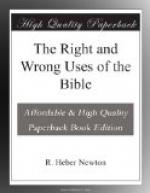Higher strata of the people worshipped the various powers of nature, the sun, the moon, the stars, after much the same fashion in vogue among their kindred Semites.[40] Even the revolting rites of the surrounding nature-worships were not lacking in Israel. While the gentle and gracious warmth of the spring sun called forth the happy adoration of the people, the scorching and consuming heat of the midsummer sun roused the fears of the sufferers for their crops, their cattle, and their very lives. They sought to propitiate this fierce Power, which was evidently hostile to man, with offerings of the life it devoured so pitilessly. The choicest lives—the first-born son, the fairest maiden of the village—were sacrificed to glut its greed of death. Into the fiery arms of Moloch parents laid the children of their love. Human sacrifices were unquestionably a recognized form of worship during this period, at least in times of deep distress.[41] The libertine longings of nature, the free fecundities of mother-earth, imaged to the grosser people the Power working round about them and within their very bodies; and men and women gave free rein to their appetites and passions, in honor of divinities like Ashera, the Syrian Venus.[42] The various tribes probably had different rites.
The general picture we must fashion in our minds of this period is of a polytheistic, idolatrous people, slightly distinguishable from the surrounding Semites, save as they held, in their recognition of Jehovah and his Ten Words, the germ of a higher thought and life.
III.
The period of the monarchy, down to the epoch of the great prophets: B. C. 1100-800.
The story of the making of England may interpret to us the development that ensued in this third period of Israel’s history. We know how the petty realms of the Angles-land, under pressure from a common foe, learned to act momentarily together, came for a summer under some commanding leader, drew thus into closer affiliations grouped gradually around the more powerful realms, and at length crystallized into England. In some such way the Hebrew tribes were slowly knit together by the necessity of war, until to organize a lasting victory they were forced into consolidation and out of the loose confederation of tribes arose a nation, Israel. Social tendencies generally throw a leader to the front. The man is not wanting for the hour. The king-maker of Israel was Samuel.




